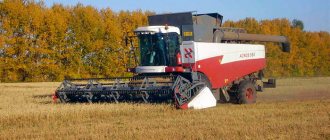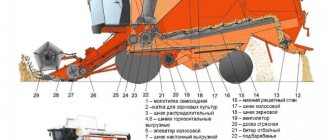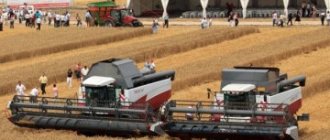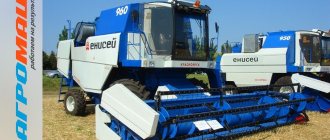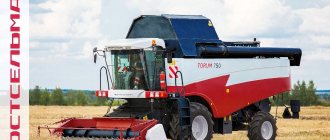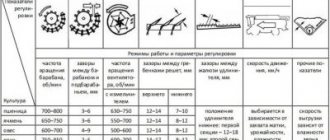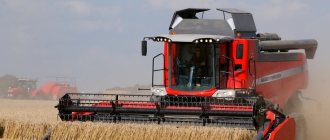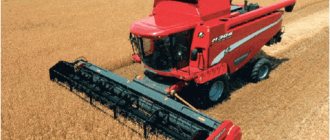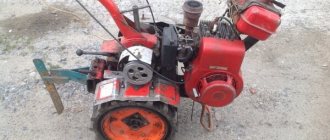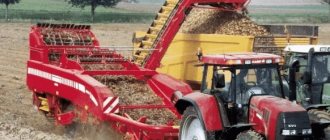AGRICULTURAL COMBINE (from the English combine, lit. - connection, combination, combination), a machine for simultaneously performing several (at least 3) technological processes. agricultural harvesting operations crops The world's first K. s. (grain harvester) created in the USA in 1836; first father The plant, built by agronomist A. R. Vlasenko, was tested in 1868 in Bezhetsky district. Tver lips. Beginning of mass use of K. s. in the world refers to the 2nd quarter. 20th century
All K. s. consist of 2 parts – motor-chassis (with control system) and technological. Technological Part of the crop plant, regardless of the crop they harvest, has devices that are general in purpose: for separating the food part of the plant (grain, seeds, tubers, berries, fruits, etc.) from the by-product part (straw, branches, leaves, tops, etc. ), for the temporary accumulation of the food part of the plant and its transportation. According to the method of aggregation of technological parts with motor running gear. are divided into self-propelled, trailed, semi-trailed, semi-mounted and mounted. In self-propelled K. s. motor-chassis and technological the parts form a single machine. In other variants of combines, the motor-chassis and technological parts are independent of each other: the engine chassis is represented by the so-called. a mobile power source (for example, a tractor), and a technological one - agricultural. a machine with its own wheels (with the exception of mounted vehicles). In trailed K. s. technological the machine is coupled to the mobile power vehicle using a towing device, and the drive of its working parts is provided by cardan shafts or a hydraulic drive system. In semi-trailer or semi-mounted trailers. technological the machine partially rests on a mobile power source, and the rest on its wheels. If less than 50% of the mass of the technological machine is transferred to a mobile power source, K. s. is considered semi-trailer, if more than 50% - semi-mounted. In mounted k.s. technological the machine is completely hung on a mobile power unit with the possibility of subsequent uncoupling, which allows the mobile power unit to be combined with technological equipment during the period between harvests. machines for other purposes. Most widespread in the 2000s. received self-propelled K. s. They are distinguished by increased maneuverability, small turning and turning radii, and ease of operation, which provides them with greater productivity. However, during the period between harvests, their engine chassis, the cost of which is 60–70% of the total cost of the plant, is not used. Trailed K. s. much cheaper than a self-propelled one, but less maneuverable, requires wider turning lanes, is difficult to control, and difficult to transport from one field to another. Mounted K. s. combines the advantages of self-propelled and trailed combines, the disadvantage is the complexity of docking and undocking it with a mobile power source.
Combine harvester
Rice. 1. Scheme of the technological process of a grain harvester with a classic thresher.
designed for harvesting grain crops so-called. by direct combining or by threshing windrows (with separate, two-phase harvesting). With direct combining, the combine harvester mows the stems along with the inflorescences, threshes them, separates the grain from the non-grain part of the crop, transports the grain to the combine hopper, and the non-grain part is either collected in a stacker, placed in a windrow, or crushed and scattered across the field. During two-phase harvesting, the combine harvester picks up a windrow previously formed by a windrower; further technological The operations are the same as for direct combining. Based on the type of threshing and separating device, grain harvesters are divided into classic and axial rotary. At the classic for combines, it includes a threshing apparatus with a beating drum (length 800–1750 mm) and a concave (deck) with a wrap angle of 90–146° and a key straw walker (length 2–4.8 m); raises the mass moves in a direction perpendicular to the axis of rotation of the drum. Axial-rotor combines are equipped with a rotor (diameter 650–800 mm, length 2–2.6 m), a fixed or rotating deck and do not have a straw walker; raises the mass moves along the axis of rotation of the rotor. Axial rotary combines are most effective when harvesting corn, as well as high-yielding, weed-free, low- and medium-sized grain crops with normal straw moisture. They provide greater grain collection per unit area and less crushing, and have high productivity (over 10 kg of plant mass per second). The disadvantage is that the straw is very chopped, making it difficult to clean and use. Classic combines are more widely used (80–85% of the total number of grain harvesters in the world), because they are more versatile in operation, adapted to harvesting a larger number of crops and various types of crops. cleaning conditions; The energy intensity of the threshing process is 10–20% lower than that of axial rotary machines. With the exception of some features associated with differences in design, technological. The operating process of all grain harvesters is basically the same. At the classic grain harvester it proceeds as follows (Fig. 1). The feeder chamber 1, containing a receiving drum and a conveyor, receives the flow cut by the header (combine header) 2 or collected by the roll picker and grows. mass, evens it out in thickness and feeds it into the threshing apparatus 3. The beater drum captures the grain. mass and directs it into the threshing gap formed between the drum and the concave grid 4. When struck and dragged, it grows. mass on the surface of the concave, the grain is threshed from the ears (97–99% of the total amount entering the threshing apparatus). The threshed grain (70–85%) and the fine fraction of the non-grain part of the crop (up to 30%) pass through the concave holes, are fed to the shaking board 5 and then to the cleaning sieves 6, blown from below with an air flow created by the cleaning fan 7. The remaining 15– 30% of the grain and up to 70% of the straw leave the surface of the concave grate and are directed to the straw walker 8, where free grain is separated from the straw. The grain, together with small particles of straw, is fed to cleaning sieves, the straw is sent to a device for collecting the non-grain part of the crop - stacker 9. Instead of a stacker, the combine can be equipped with a straw chopper-spreader or a straw windrower. The grain, cleared of straw impurities, is moved by the grain elevator 10 into the grain bin of the combine 11. The spikelets with unthreshed grain that come off the lower sieve are sent by the grain elevator 12 to the pre-threshing device 13, the threshed grain together with straw particles is fed to the cleaning sieves. Ch. the characteristic of a grain harvester that determines its class is throughput (the amount of plant matter threshed by the combine in 1 second when harvesting ripe grain of normal moisture, the ratio of grain mass to straw mass is 1: 1.5, grain loss is no more than 1.5% and grain crushing no more than 2% for food and feed grain). In the Russian Federation, a six-class type of combines has been adopted for producing commercial grain: 3; 5.5–6; 7–8; 9–10; 11–12 and 14–15 kg/s. There are different modifications of the combine harvester for working in difficult conditions (high humidity, contamination, etc.), they are distinguished by the presence of two drums and an all-terrain running gear (arched tires, crawler or half-track, pneumatic tracks, etc.).
On the basis of grain harvesters through some design changes, retrofitting with replaceable devices or additions. components and assemblies have created a family of combines for harvesting cereals, grain feeds, industrial crops, oilseeds and grasses for seeds. A rice harvester has a threshing apparatus equipped with two drums (pin and beater), between which there is a separation zone with one or two intermediate beaters (four-bladed drums with a diameter of 300–400 mm). The first beater (breaker) removes the growth. mass from the first threshing drum. The second beater (receiver) takes over. the mass from the first beater and feeds it into the second threshing drum. Under the beaters there is a rod separating grid. The corn harvester is equipped with special equipment. an attachment header for simultaneous harvesting of 6, 8 or more rows and a mounted stem chopper. Corn cobs are torn from the stalks in the “streams” of the header and fed into the threshing apparatus, the stalks are crushed and sent to the body of a vehicle moving independently next to the combine harvester. If the combine is not equipped with a stalk chopper, then the stalks without cobs remain on the field. A sunflower harvester operates on the same principle. It is equipped with a special header attachment for 6, 8 or more rows, cutting off the caps and parts of sunflower stems and feeding them into the thresher. At the same time, the main Some of the sunflower stems can remain standing or crushed and scattered across the field. cutting device installed between the header attachment and the front wheels of the combine. The castor bean harvester is equipped with a special header for cutting castor bean stems and feeding them into the thresher. The designs of the concave and cleaning sieves and the operating modes of the threshing drum have been changed. The combine harvester for harvesting herbs for seeds is equipped with special equipment. a grinding device and a set of sieves with smaller diameter holes. The rapeseed harvester is equipped with special equipment. “rapeseed table”, extending the header platform. The rapeseed table is equipped with two side vertical cutting devices for cutting tangled stems, which allows reducing seed losses by 2–5 times compared to using a conventional combine harvester.
How different models work
Depending on the design of the threshing separating unit, threshing devices are:
- rotary type;
- drums;
- mixed.
The features and mechanism of work of these groups can be considered in more detail.
Rotary
In the design of a rotary machine, the threshing unit is represented by a rotor. Rotating, it creates centrifugal force, which contributes to threshing of grain. These are convenient and productive combines, so they are perfect for processing large, high-yielding fields. An additional advantage is low labor intensity, reduced number of drives and rotating mechanisms. However, there are some disadvantages:
- the equipment cannot work with wet raw materials;
- The machines show their greatest performance only in dry, hot areas;
- expensive maintenance and increased resource consumption.
On a note!
The rotary grain harvester is suitable for large agricultural enterprises. Since the price of such equipment is high, it is not advisable to purchase it for personal use.
Drums
The design of such combines (they are also called keyboard harvesters) can be called classic. At the front of the machine there are knives that cut the chaff and transfer it to the reel. It collects the stems and moves them to the header. With the help of rotating augers, the ears are moved into the conveyor pipe, and then into the threshing department. The threshing drum threshes the raw materials. The portion separated from the chaff is poured onto the screen through the deck, and the unthreshed parts undergo another processing. In this case, the stems are cut or go into a storage bin, and the grains are winnowed and poured into a special compartment. From there they can be poured into truck bodies. At the same time, the productivity of drum technology is two or three times less than that of rotary technology.
Potato harvester
Rice. 2. Scheme of the technological process of a potato harvester.
produced in self-propelled, trailed and mounted versions; diff. models can harvest potatoes from 1 to 3 or more rows at the same time. Depending on the design, the operating staff of a potato harvester ranges from 1 to 7 people. Technological The operating process of most potato harvesters is similar, the models differ from each other. arr. design of the department units (plowshares, shakers, lump crushers, etc.). When the combine moves (Fig. 2) along the rows of potatoes, plowshares 1 cut the soil layer below the base. tiers of tubers, lift it and direct it to rod elevators 2. In front of the plowshares there are sometimes ridge drums that help guide the combine along the soil ridges containing tubers. To loosen the incoming formation, shaking devices 3 are installed under the elevators. On the first elevator, the main. some of the soil particles are separated and poured through the gaps between the rods onto the ground; on the second rod elevator, characterized by a smaller distance between the rods, fine soil fractions are separated. Next, the mixture goes to the clod crushers 4, which crush large lumps of soil, and is sent to the third elevators 5, after which it passes through the topping device 6 and is divided into two streams. The tubers, cleared of soil and tops, from the lifting drum 7 arrive at the bulkhead table 8 and grow. mass (tops, weeds), etc. - to the impurity conveyor 9. On the sorting table, the tubers are sorted manually (usually 2-4 people). The sorted tubers are sent to storage by conveyor 10. bunker 11 or into the body of a vehicle. Some models of potato harvesters provide for sorting tubers by size and packaging them into bags. The productivity of trailed combines is up to 0.35 ha/h, self-propelled four-row harvesters – up to 0.9 ha/h.
Proper equipment care
The durability, performance and duration of operation of combine harvesters depends on timely and regular care of its working mechanisms. All units and components are checked, especially those that carry a heavy load. The appropriate settings for the drum, heap, and coupling cleaning system are set (50 kg/m).
All parts are lubricated with high-quality oils. Check the tension of the chains and the fastening of the drive sprockets. Once every two years, fuel equipment is checked at the stand. With proper care, the engine of a combine harvester will last 10-13 years.
Flax harvester
Rice. 3. Scheme of the technological process of a flax harvester.
provides separate collection of seed pods and stems (flax straws) of fiber flax. Flax harvesters mainly trailed and aggregated with tractors. When the combine moves across the field (Fig. 3), wedge-shaped dividers 1 divide the flax into rows, each of which enters a separate “stream” of the lifting apparatus 2. In the lifting apparatus, the flax stems are clamped by lifting belts, pulled out of the soil and placed on a transverse needle-type conveyor 3, the needles of which move the stems according to a special pattern. guide plates to the clamping conveyor 4. The belts of the clamping conveyor clamp the butt part of the stems, while the apical part of the stems is combed by the combs of the combing drum 5. The flax heap (seed pods and pedicels separated from the stems) is directed by the conveyor 6 into a cart attached to the combine. The layer of combed flax leaves the clamping conveyor and enters the table of the knitting machine 7, which forms portioned sheaves. The sheaves are dumped on the field. Instead of a knitting machine, a spreading table can be installed, with the help of which the stems are spread on the field in the form of ribbons. The productivity of flax harvesters is up to 1 ha/h.
Grape harvester
Rice. 4. Scheme of the technological process of a grape harvester.
self-propelled machine for cleaning technical equipment. grape varieties. It works in vineyards with row spacing of at least 2 m. The working parts of the combine are mounted on a high-clearance portal-type chassis. The combine (Fig. 4) is equipped with finger and whip shakers 1, consisting of one or two sections and equipped with impact rods made of fiberglass 2. When the machine moves over the vineyard row, the rods hit the bushes. From the impacts, the fruits fall onto the catchers 3, roll onto the conveyors 4 or into elevator buckets for feeding into the bunkers 5. During the movement, the fruits are cleaned of impurities by the air flow created by the blower fans 6. From the bunker, the berries are unloaded into vehicles traveling along the adjacent row. When harvesting difficult-to-remove grape varieties, reduce the operating speed, increase the amplitude or frequency of vibrations of the finger shaker rods, or use drum shakers. The drums perform transverse vibrations, shake the bushes, and the berries come off. They produce models that harvest grapes on the plain and areas with a slope of up to 5°, and models for working on areas with a slope of up to 12°, the latter equipped with a horizontal position stabilization system. Machine productivity is 0.4–1.0 ha/h. The completeness of harvesting from the bush is up to 99%, the completeness of catching berries is up to 99.6%. Whole bunches and berries account for up to 77% of the harvested grapes.
Harvesting equipment for grain farms and small farms
A mini combine harvester for grain harvesting is a new direction in the agricultural engineering market. Along with foreign-made models from the companies Claas, DongFeng, John Deere, domestic devices Zarya and Farmer are offered.
Mini harvesters are equipped with a header, a threshing device and a winnower. They combine compact size, versatility and efficiency of use, with low maintenance and fuel costs.
- The Zarya combine harvester will harvest 600 m2 of field in one hour, consuming only 400 g of diesel fuel. Works on cereals, corn, sunflower, soybeans and rice.
- The single-drum combine harvester “Farmer” is a more powerful machine - with a thresher throughput of 3 kg of grain mass per second, it collects 3 tons of grain per hour of operation.
- The German mini-unit Class Consul is equipped with an effective threshing mechanism. The power plant is supplied by Perkins and Mercedes-Benz. The transmission is hydrostatic.
- The Chinese mini-harvester DongFeng works well for wheat in fields of limited size, but does not pretend to be used for many years. Frequent oil leaks, significant consumption of fuel and lubricants, premature wear of parts.
Beet harvester
self-propelled or trailed machine for harvesting the roots of sugar and fodder beets. He cuts the tops, digs up the beet roots, removes them from the soil, cleans them of soil and grows them. residues and loads it into a bunker, which acts as an intermediate container (capacity 5–15 tons), or into the body of the next vehicle. The tops trimmer can be made in the form of a horizontal rotary chopper or a disk cutting device. Digging devices are, as a rule, disc or plowshare vibrating diggers, which are more effective than previously used lifting (for tops) devices. The root cleaner is made in the form of a rod conveyor or a system of active rotors with fingers arranged fan-shaped along the periphery. Modern combines have an autopilot to stabilize movement along the rows of beets, mechanisms for regulating the depth of travel of the diggers, the position of the tops trimmer and the height of the unloading conveyor; main drive working bodies are hydrofitted; management and control of technological The process is carried out using an on-board computer. Beet tops can be scattered across the field and used as organic matter. fertilizers or placed in windrows for subsequent collection and use as livestock feed. Depending on the design, beet harvesters can harvest from 1 to 6 or more rows at a time. Productivity up to 2 ha/h.
Berry harvester
self-propelled machine (specialized or in the form of a harvesting module mounted on a self-propelled chassis with increased ground clearance) for harvesting currants and chokeberries on young plantations. For the combine to operate, row spacings of 2.5–3 m and distances between bushes in a row of 0.5–0.7 m are required. When the combine moves along the rows of bushes, the shaper lifts the inclined branches of the bush, divides them into two parts and inserts them into the activator channels. In the activator, whips are installed on vertical pipes that oscillate in the horizontal plane, which shake off the berries from the branches; the activator presses the bush and stabilizes it in a vertical position with the help of a catcher. The catcher consists of freely rotating reinforced rubber discs mounted on spring-loaded arms and an active central berry deflector; in addition to stabilizing the bush, it ensures the capture of picked berries and their delivery to longitudinal belt conveyors. The conveyor scrapers carry out the berries and grow them. impurities (leaves, stalks, etc.) to a cleaning system that removes impurities using a suction air flow created by fans. The berries are fed to the unloading device using longitudinal conveyors. On both sides of the combine there are areas for temporary accumulation of empty boxes. Placement of boxes on the unloading device and their replacement is done manually (the combine is operated by 2–4 people, for whose placement there is a special platform with stairs and handrails). The productivity of berry harvesters is 0.4–0.9 ha/hour, the completeness of berry harvesting is up to 90%.
Models of foreign factories
John Deere combine is one of the most popular in the world. The advantage of using it is a harmonious combination of price and quality. Maximum reliability and ease of operation. Combines of this brand are used in fields with a large volume of work, including on inclined surfaces. A powerful engine (305 hp) of its own brand and a well-functioning mechanism of hydraulic and electrical systems allow it to work even in rain. Dimensions of the combine: 8.98 m long, 3.77 m wide. Advantages include the presence of:
- “catcher” of stones;
- cleaner;
- accelerator device for feeding cut raw materials.
John Deere
Combine "Claas Tucano-450" is a representative of the premium class. The machine is equipped with a multifunctional pipeline connection system and a central lock. The header is equipped with a control unit with memory of previously set modes. Inside there is a powerful and reliable Mercedes-Benz engine and a large fuel tank (650 l). This allows uninterrupted operation in remote fields.
Attention! The successes of Claas combine harvesters are included in the Guinness Book of Records.
Forage harvester
machine for mowing green crops and picking up swaths of dried seeded or natural crops. herbs, as well as for harvesting tall crops (corn and sunflower) with simultaneous chopping and loading. mass into the body of a vehicle moving nearby. It is produced in self-propelled and trailed versions, equipped with a header or windrow pick-up and a drum or disk-type chopping apparatus. Grass cutting capacity 22–40 t/h; when selecting rolls 15–70 t/h; when mowing tall crops 30–150 t/h.
Forage harvester
machine for harvesting green mass of corn, sunflower and other forage crops for silage. It is produced in self-propelled and trailed versions, equipped with a header and a drum-type chopping apparatus with a device for sharpening knives. The combine mows down the plants, crushes them and feeds them through a silo into the back of a vehicle moving nearby. Productivity 1.5–2.0 ha/h.
K. s. can be equipped with a computer system for monitoring grain yield in real time during harvesting along coordinated sections of the field. The system is controlled using satellites. The memory card received in the field is read by office equipment and printed in the form of field yield maps used in the precision farming system (see article Farming systems).
